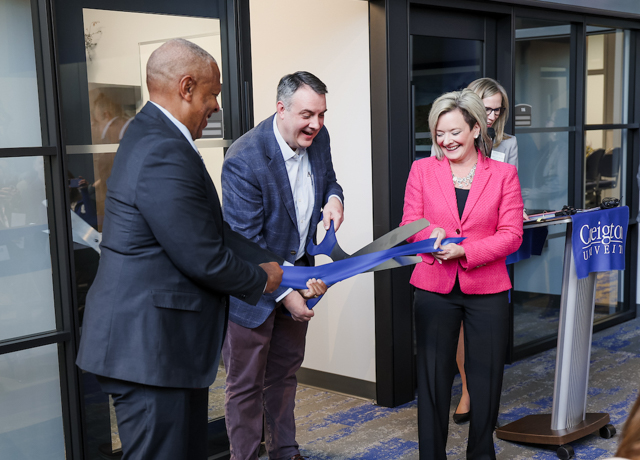Featured Testimonial About Creighton University
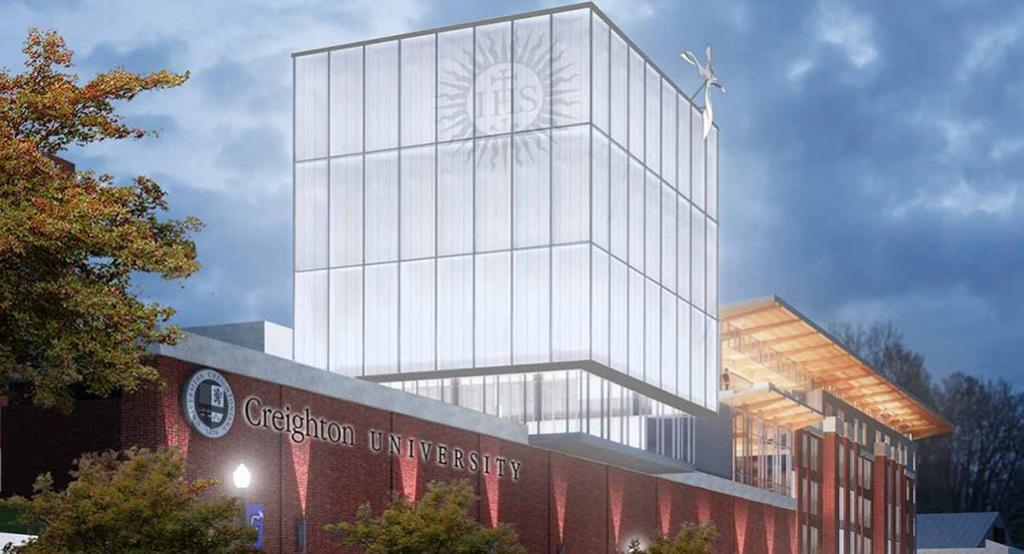
Here are a few words about what the Jesuit Residence means for Creighton. From cloister to inclusion. From walls to welcome. From fortress to home.
The Jérôme Nadal, SJ, Jesuit Residence, expected to be completed in the 2023-2024 academic year, will stand along 24th Street at the east edge of the Jesuit Gardens, behind Creighton Hall and St. John’s Church.
* * *
By Micah Mertes
This is a story about a building. But more than that, it’s about what the building represents to Creighton’s past and its future.
“If you want to get symbolic,” says the Rev. Larry Gillick, SJ, director of the Deglman Center for Ignatian Spirituality and a member of Creighton’s Jesuit community for more than 40 years, “the new Jérôme Nadal, SJ, Jesuit Residence will face out and face in. It faces out toward 24th Street, toward the busy world of trucks and buses and cars. It faces in toward the peace and serenity of the new Jesuit Gardens.”
What’s true of the building is true of the Creighton Jesuits themselves.
Jesuits live between action and reflection. Their spirituality charges head first into the everyday of a messy world … then reboots in the quiet contemplation of home.
“My definition of ‘home’ is a place that receives you, then sends you back out into the world, over and over, again and again,” Fr. Gillick says.
What’s true of Creighton’s Jesuits is true of the whole Creighton community.
More than 30 Jesuits are now assigned to the campus community, yet they’ve touched the lives of tens of thousands. (Who have, in turn, touched the lives of many more.)
If you want to get symbolic in a different way ... imagine Creighton University as a river. If the Jesuits themselves are the main stream, then every graduate, student, professor and staff member is a potential distributary, feeding Creighton’s values to all corners of the world.
Where does the new Jesuit Residence fit in to the metaphor?
It’s the place where all streams meet.
* * *
"Students and campus visitors often tell me that Creighton University ‘feels like home.’ One of the main reasons they feel at home here is the Jesuit community at the heart of our campus and our mission."
— The Rev. Daniel S. Hendrickson, SJ, PhD
* * *
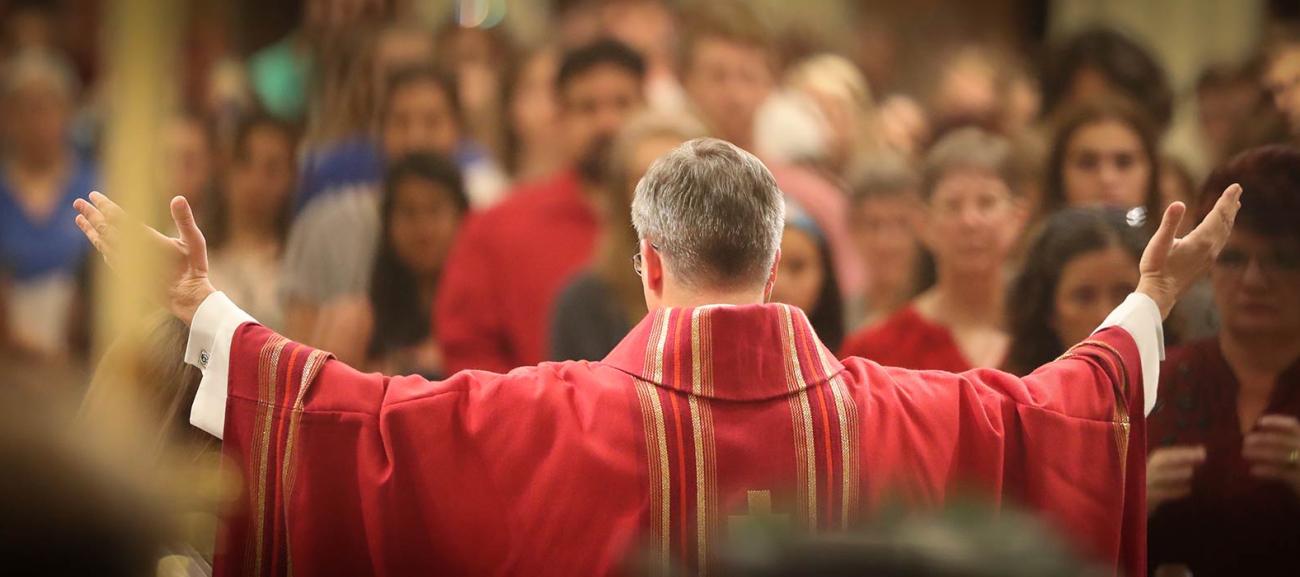
Creighton University has seen a handful of key moments in its history. This is one of them, says Creighton President the Rev. Daniel S. Hendrickson, SJ, PhD.
“As it did in the 1960s, a lot has happened at Creighton in a very quick timeframe,” he says. “Creighton continues evolving and extending its mission creatively and concisely.”
He mentioned the 24th Street beautification, the reimagining of the Harper Center and Heider College of Business, the Heaney Bridge connecting campus to Omaha, as well as the in-development residence hall, CL Werner Center for Health Sciences Education, renovated laboratories and the Jesuit Residence.
These buildings and improvements are, of course, necessary (in addition to being aesthetically pleasing). But, along with non-facility advances, such as an impressive 11 new endowed faculty chairs, they also represent and showcase some of the core strengths Creighton is investing in. Such as the Jesuit presence on campus.
“The new residence will be a venue that will celebrate and support Creighton’s Jesuit legacy and presence, inviting colleagues and guests to share in our lives in myriad ways,” Fr. Hendrickson says. “It is a symbol of our deep commitment to sustaining and enhancing the Jesuit, Catholic character of Creighton for future generations of students, faculty and staff.
“We should think of this moment as the second founding of the Creighton Jesuits.”
When planning the new Jesuit Residence, Creighton identified three key themes for the building that embody the campus Jesuits themselves: visibility, access and hospitality.
While you can find the Jesuits in all corners of campus, their current living quarters — tucked into Creighton Hall and barred by a golden elevator — are anything but visible or accessible.
Most of the Jesuits we spoke with called their living situation in Creighton Hall “a fortress.”
“That changes with the new residence,” says the Rev. Nicholas Santos, SJ, PhD, a Creighton professor and rector of the Jesuit community in Omaha. “Every student, faculty and staff member will be welcome to access our chapel and gathering spaces. And we will be out there, facing 24th Street, for all of Omaha to see.”
The residence, he says, will be a true front door to Creighton.
* * *
“Here are a few words about what this Jesuit Residence means for Creighton. From cloister to inclusion. From walls to welcome. From fortress to home.”
— Fr. Gillick
* * *
As Pope Francis, a Jesuit himself, says of the religious order: “The world is our home.”
Jesuits commit their lives to going where they’re asked to. Many don’t stay in the same place for long. One of the things that makes Creighton’s Jesuit community so unique is its many major exceptions to that rule.
The Revs. Gillick, Don Doll and Greg Carlson have lived and taught here for decades. Other Jesuits saw equally long tenures, like the recently retired Rev. Tom Shanahan or the Rev. Dick Hauser, who died in 2018 and more than lived up to his desired epitaph: “He helped us recognize God’s presence in our lives.”
“Creighton,” Fr. Hendrickson says, “has been truly blessed to have a group of Jesuits who have been building relationships and making inroads with our students, faculty and staff for many years.
“They were very prescient in the need to share Ignatian spirituality and formation with their colleagues. Due in large part to their efforts, our faculty and staff are fully engaged and empowered as owners of our collective mission.”
When Fr. Gillick arrived at Creighton, he says, the Jesuits and lay faculty and staff respected each other and worked together, but there was a bit of a divide.
He and other Jesuits chipped away at that wall for decades, through faith-sharing groups, Christian Life Communities and Ignatian Spiritual Exercises courses with their lay colleagues.
“More and more,” Fr. Gillick says, “the faculty and staff have come to realize that they carry the mission of the University as much as the Jesuits do.”
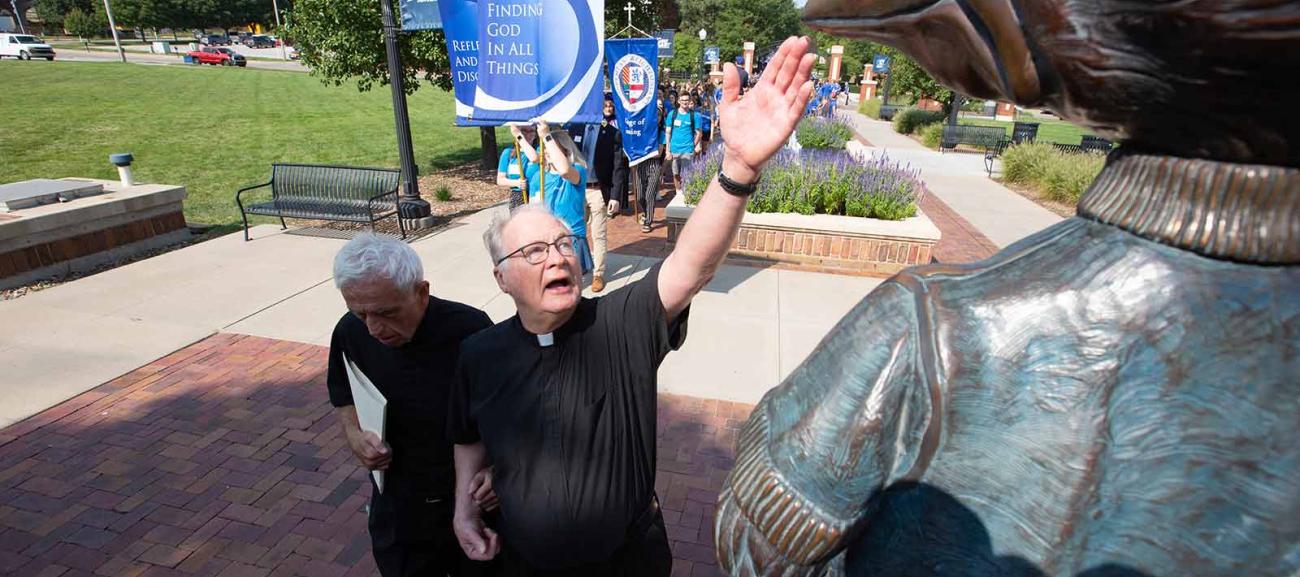
Jeanne Schuler, PhD, a philosophy professor with Creighton since 1981 and a product of a Jesuit education herself, says many faculty were part of the same faith-sharing groups for decades. It’s something that has not only enriched the professors’ lives but, downstream, the students they teach, as well.
“The Creighton Jesuits have done a remarkable job of making the mission exciting and intellectually stimulating to all faculty and staff,” she says. “There is never a sense that this is something that’s being imposed on me and that I have to accept to keep my job.”
It’s quite the opposite, Schuler says. It’s a call to renew intellectual life. She likes to tell her philosophy students that 500 years ago, a Basque Spaniard priest started a tradition of education committed to the mind — “to reflect, to examine, even sometimes to criticize” — that remains just as relevant and useful today.
“What an achievement,” she says, “to be so rooted in tradition yet so fully open to the world.”
* * *
“The Jesuits teach in the classroom and encourage on campus. For students, they encourage growth, liveliness, interaction, involvement and a personal sense of mission. The Jesuits at Creighton are much more available and involved with the students than at most Jesuit universities. It’s just the spirit here.”
— Fr. Gillick
* * *
The Rev. James Clifton, SJ, associate dean of Mission and Identity in the School of Medicine, started his journey nearly 50 years ago, as a Creighton business freshman.
By this time, he already had a job he loved, working in the legal department of a phone company. He thought he’d be there forever. But his plans were soon spoiled.
“And I thank God for that,” Fr. Clifton says now. “My plans changed as I met Jesuits and members of Campus Ministry. Through them, I discovered a faith that was a lot more grounded in making a difference in real life. As an alumnus and now a Jesuit, I believe that Creighton does as remarkable a job as any Jesuit university in the nation at inviting everyone into our world.”
Now, when he sees others’ plans “ruined” in the best way, it sparks a particular kind of joy in Fr. Clifton.
So many students come to Creighton for one reason and leave with a different purpose, he says. Some of this stems from the University’s curriculum being rooted in the humanities, with a breadth of programs encouraging students in all fields to explore areas and discover passions they might not have otherwise.
“Creighton students don’t often follow a linear, undisturbed path,” Fr. Clifton says. “They come here to discover who they are, their very best selves, their best way to serve God in the world.”
* * *
Tales of plans botched and paths disturbed are common at Creighton.
Hayden Hubbs, BS’22, was born and raised Episcopalian, but she’d gone to a Jesuit high school and already fallen in love with Ignatian spirituality by the time she arrived at Creighton.
She was pre-med, a biology major. She loved it, yet over the years she felt called to pursue a minor in theology, too.
Her last semester at Creighton, she was prepared to take the next steps toward medical school. Then she ran into Fr. Gillick on campus one day. He encouraged her to take the Spiritual Exercises class. That same semester, Hubbs also took a liberation theology course from professor Tom Kelly, PhD.
Those two classes in particular helped Hubbs realize she wanted to take a more ministerial path into health care. She now hopes to become a hospital chaplain.
In the meantime, she’s found the perfect place to serve. This fall, Hubbs moved to Tacoma, Washington, to work for L’Arche Tahoma Hope, a community that cares for people with intellectual disabilities.
She thanks Jesuits such as Fr. Gillick, who “kept me walking down the right road. Which ended up being a different road.”

Having the Jesuits so woven into the daily life of campus, Hubbs says, “helps you remember Creighton’s original mission and makes you feel like you’re a part of it and this community. And if you’re grappling with the path of discernment, there’s always a Jesuit nearby.”
Hunter Allen, BSBA’14, MD’22, had an inverse journey to Hubbs’. His detour led him to medicine.
Allen was a Heider College of Business accounting graduate who decided to become a physician. The reason for the switch, as much as anything, was his time working as a bus driver.
Though he loved his business school experience, he’d decided this maybe wasn’t for him. Nonetheless, he was committed to earning his accounting degree. To support himself his junior and senior years of business school, he drove a school bus for Omaha Public Schools.
Allen would pick up and drop off elementary and high school students from class, park the school bus by Creighton Public Safety, run to the Harper Center for his classes, then head back to the bus to finish his day.
“That experience changed everything,” Allen says. “Every day, 30 sets of parents trusted me to keep their children safe. I realized that I thrived in the responsibility of caring for the well-being of others. I realized that this … this is when I like me best. And that realization led me to medicine.”
Allen, who comes from a rural area near Dallas, is doing his residency in rural family medicine at the Lincoln Medical Education Partnership in Nebraska. His hope is to stay in the state and treat families in the North Platte region.
Allen’s bus-driving epiphany aside, it was the Creighton Jesuits who played a key role in his career pivot.
“One of the reasons the Jesuit mission at Creighton is so effective at helping people figure out where they fit into the world,” he says, “is just how clearly the Jesuits fit into Creighton.”
The Jesuits are mentors but also models for living, Hunter says. “They project that presence and positive outlook to everyone they meet. They instill confidence, and in doing so, allow others to become the greatest versions of themselves. Though I may not be a Jesuit, that is how I wish to live my life.”
Some Creighton students are so influenced by the Jesuits they choose to become Jesuits themselves.
Patrick Fenner, SJ, BA’20, is a Jesuit scholastic in Chicago who recently returned from living in a Jesuit community in Peru.
Fenner doesn’t recall a eureka! moment when he knew he wanted to join the Society of Jesus. It was a slow realization.
“It was a build-up of simple interactions with Creighton Jesuits,” Fenner says. “Sometimes in the classroom, sometimes at Mass, sometimes just walking along the Mall. It was just seeing the Jesuits. Being with them. Learning all the different things you can do as a Jesuit.”
Those experiences added up for Fenner, steered him in a new direction. They also solidified something he’d been mulling over for years: “Whatever you decide to become, when you walk out Creighton’s doors, you’re not done with the Jesuit mission. You’re just getting started.”
Fenner himself is studying to become a professor and plans to one day teach at a Jesuit high school or university.
If he ever does end up returning to Creighton University — some streams flow back into the main river — he’ll have a beautiful building to call home.

More about the Jesuit Residence
The Jérôme Nadal, SJ, Jesuit Residence, expected to be completed in the 2023-2024 academic year, will stand along 24th Street at the east edge of the Jesuit Gardens, behind Creighton Hall and St. John’s Church.
The residence will be home to Jesuits who live, serve and work on campus as instructors, pastors, chaplains and University administrators and staff. The 37,779-square-foot building will be accessible to students, faculty, staff, alumni and Omaha partners for Mass, spiritual counseling and other mission-based programs. The residence will include 28 bedrooms for Creighton Jesuits, as well as a 1,015-square-foot chapel, a dining hall, library and several spaces for spiritual activities.
The new residence will also support the Creighton Jesuits’ work in Omaha and the broader global Jesuit community, hosting meetings and fellowship for those from Creighton Prep, Jesuit Academy middle school in North Omaha, Cloisters on the Platte and the Creighton Retreat Center in Griswold, Iowa. Jesuit scholars visiting from around the world will stay in the facility’s guestrooms.
It will feature a chapel named for Our Lady of Montserrat, with its connection to the life and spiritual journey of St. Ignatius of Loyola, founder of the Jesuit order. In 1522, a knightly Ignatius, injured in battle and seeking a new life, traveled to the abbey at Montserrat in northern Spain, where, after spending a night praying before the statue of the Virgin Mary and Christ Child, laid down his sword and vowed to live as a humble pilgrim.
The construction of the Jesuit Residence, demolition of existing structures and renovations to the Jesuit Gardens are supported through donor investments. The facility was initiated with lead gifts from Teri and Ron Quinn, BSBA’70, MBA’76; Mary Pat and Dick McCormick, BS’62, and HON’88, respectively; Physicians Mutual and the Reed Family; Ann and Ken Stinson; and Nancy and Mike McCarthy.
“We are humbled and forever grateful to the donors who have made this possible,” says the Rev. Nicholas Santos, SJ, PhD, rector of the Jesuit community in Omaha and associate professor of marketing at Creighton. “They felt called to make sure that our vibrant Jesuit community continues to thrive, serve others and guide our students.”
The project is part of the Forward Blue campaign, which embraces Creighton’s Jesuit identity and emphasizes support for scholarships, programs, services and spaces across the University’s campuses in Omaha and Phoenix. To learn more, visit creighton.edu/forwardblue.
The Jesuit Residence construction live stream
The tradition continues
Creighton opened its doors in 1878 with a faculty of one Jesuit priest, three scholastics and two lay professors. The first group of Jesuits met at the Union Pacific Transfer Station depot in Council Bluffs — as far west as the track’s eastern trains came those days.
The only bridge across the river into Omaha was also owned by U.P. It cost each Jesuit 25 cents to cross the bridge into the city. As Omaha roads were still unpaved at this point, their carriage ride to Creighton was a bumpy, dirty and difficult one.
When they finally arrived, they brought to campus and Omaha a Jesuit presence that still endures today.
Nearly 150 years since the first Jesuits arrived on campus, Patrick Saint-Jean, SJ, PsyD, lives and works here today.
Saint-Jean — a psychology professor and a psychotherapist in the University’s counseling center — recently began his third and final year as a Jesuit regent assigned to Creighton. Saint-Jean has seen much of the world. He was born in Haiti, studied in Paris, and has worked and lived in such places as Italy, the Congo, Brazil and Mexico.
Of all the places he’s lived, he says, Creighton and Omaha stand out as among the most welcoming. It’s a matter of interlocking communities supporting a larger, collective purpose. The city supports the University, which supports the campus community (Jesuit and otherwise), which in turn gives back to Creighton, Omaha and far beyond.
“There is a sense of belonging here,” Saint-Jean says. “This is a home where you feel loved. As Jesuits at Creighton, we do not just teach in the classroom, then go back to our rooms. We make ourselves available. We are always here, to bring that love and spirit of belonging to all the people we meet in our daily encounters, so that we may all take that spirit everywhere.”
More about Jérôme Nadal, SJ
“The ultimate and even most preferable of [Jesuits’] dwellings are not … houses but the highways. We identify the Society’s final and ultimate dwelling … with a journey” | “the whole world becomes our house” – Jérôme Nadal, SJ, 1507-1580
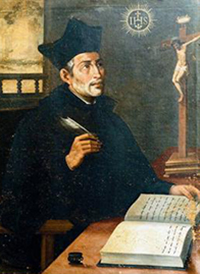
The above quotations from Jérôme Nadal, SJ, one of the early companions of St. Ignatius of Loyola, founder of the Jesuit religious order, is affixed prominently, in raised letters, on the wall outside the Creighton Hall office of University President the Rev. Daniel S. Hendrickson, SJ, PhD.
These words also animate Creighton’s work at the Health Sciences Campus – Phoenix, inscribed on a plaque affixed to the sculpture of St. Ignatius at the entryway to campus.
In the book Jérôme Nadal, SJ, 1507-1580: Tracking the First Generation of Jesuits, author the Rev. William Bangert, SJ, and editor the Rev. Thomas McCoog, SJ, describe Nadal as one of Ignatius’ closest confidants, recognized as an “authentic interpreter of the Ignatian vision and spirituality.”
According to Jesuit scholar, historian and author the Rev. John O’Malley, SJ, St. Ignatius entrusted Nadal with promulgating and interpreting the Society’s new Constitutions to a nascent, but growing, Jesuit community across western Europe.
In addition, Nadal was involved in the Society’s early work in education. Along with nine other Jesuits selected by Ignatius, and with approval from the pope, Nadal helped open the first Jesuit school in Messina, Italy, in 1548, and gave lectures in scholastic moral theology.
Nadal is believed to have coined the phrase “contemplatives in action” to describe Ignatian spirituality, wherein prayer, reflection and discernment compel one to act in service to God in society, distinctive from monastic orders prevalent at the time. Jesuits today often describe this approach as engaging the nitty-gritty of the world.
“Nadal himself preferred the image of a circle: a Jesuit’s prayer flows into his work and his work into his prayer,” conclude Frs. Bangert and McCoog in their biography. “In Nadal, theory and practice emerge.”
And so, too, in the new residence hall named in his honor.

